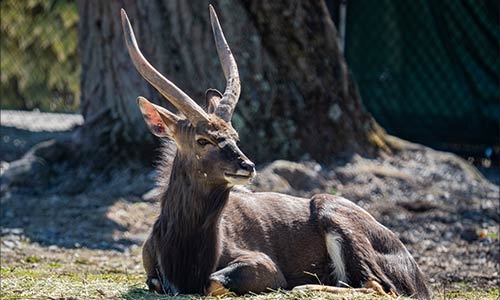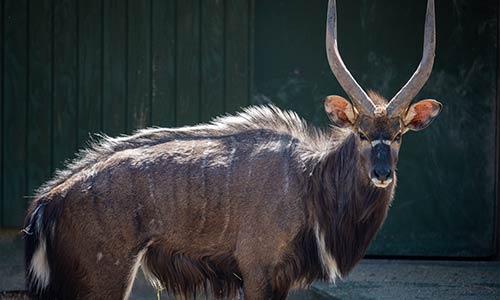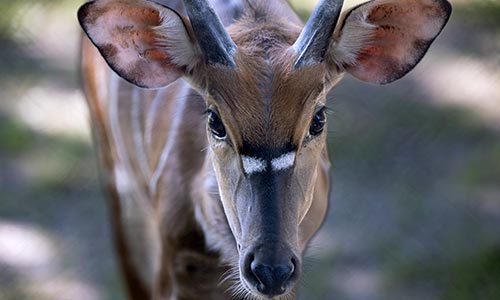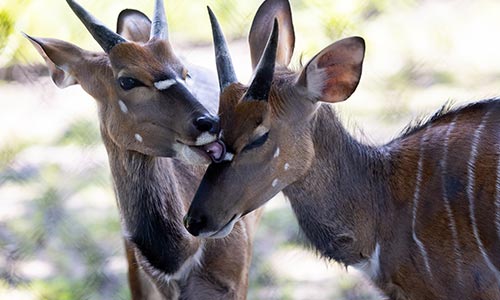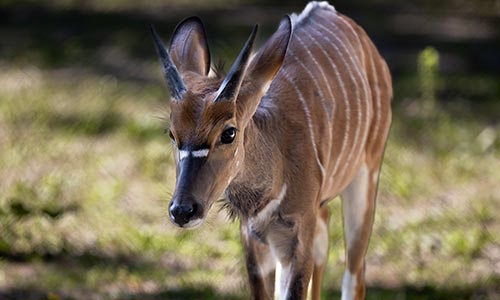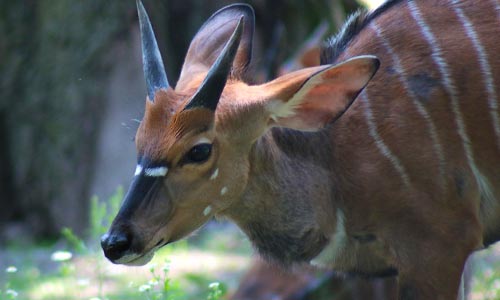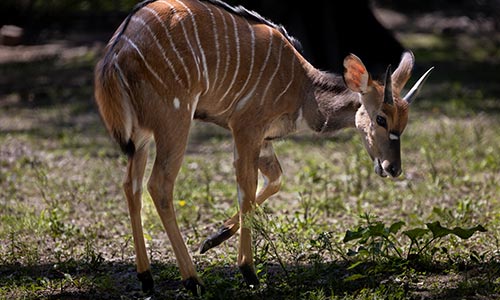Lowland Nyala
Tragelaphus angasii
About the Lowland Nyala

Geographic Range:
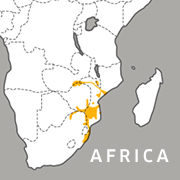
Class: Mammalia
Order: Cetartiodactyla
Family: Bovidae
Genus: Tragelaphus
Species: angasii
The lowland nyala is an antelope species found in the grasslands and woodlands of southeastern Africa. Nyala exhibit one of the most extreme examples of sexual dimorphism (a difference in appearance between males and females) of any antelope. Females are about half the size of males, hornless, and a rusty brown color with vertical white stripes. Males have large spiral horns and a shaggy greyish-brown coat. Nyala are sociable and can be found in groups of up to 30 individuals.
Committed to Conservation
African wildlife, including species like lions and elephants that coexist with nyala, is in both decline and significant peril due to overhunting and habitat loss. Conservation efforts like community-led initiatives to lessen overgrazing, tree cutting and hunting have helped the nyala population survive.
You Can Help!
You can help preserve and protect nyala habitat by shopping sustainably, recycling and reducing your carbon footprint. For example, by recycling your phones, you help protect animals living in areas of Africa where cell phone materials are mined. Bring your small electronics to our Zoos, or better yet, start your own recycling campaign! Learn more about recycling with Zoo New England.
Lowland Nyala Facts
Appearance:
Nyala are closely related to several species of spiral horned antelopes including bongo, sitatunga and bushbuck. This species exhibits one of the most extreme examples of sexual dimorphism (a difference in appearance between males and females) of any antelope. Females are about half the size of males, hornless, and a rusty brown color with vertical white stripes. Males have large spiral horns and a shaggy greyish-brown coat. Nyala have vertical white stripes when young, but these stripes start to fade as the animal matures.
Size:
- Males:
- Height: 42 inches tall at the shoulders
- Weight: 216-276 pounds
- Females:
- Height: 26 inches tall at the shoulders
- Weight: 121-150 pounds
Diet:
Nyala both graze and browse. They eat leaves, twigs, flowers and fruits of many types of plants, but during the rainy season, they primarily eat grass. Nyala are often found in close proximity to foraging monkeys, readily eating fruit that monkeys drop from the trees.
Reproduction:
While nyala can breed at any time of year, there is usually a peak in the spring and a smaller peak in autumn. Females reach sexual maturity at 11 to 12 months of age, and males at 18 months. Males are not usually able to compete for females until they are around 5 years old. Calves are born after a seven-month gestation and weigh about 11 pounds at birth.
Behavior:
Nyala are sociable and can be found in groups of up to 30 individuals. Males often band together, but these groups are usually transitory with individuals not forming any long-term bonds. Nyala aren’t territorial and home ranges of various groups regularly overlap. Females often remain in the same herd as their mothers, even after having calves of their own. Nyala aren’t particularly aggressive or fast, so they avoid predators by remaining concealed in the brush. Males will display aggression by raising their dorsal crest (hairs running down the spine), arching their necks, and holding their tails up. Both sexes make a barking call to warn of danger, which other species will respond to.
Habitat/range:
Nyala are found in southeastern Africa, near thickets and dry savanna woodlands. Although they’re often found near a water source, nyala can survive in conditions where water is only available seasonally.
Threats:
Threats to this species include poaching, habitat loss, hunting and competition with domestic livestock.
You Can Find This Animal in the Kalahari Kingdom
You Can Help!

You can help preserve and protect wildlife habitat by shopping sustainably. Look for the RSPO and Rainforest Alliance labels before purchasing.
Who's Who?
Nyala are extremely sexually dimorphic, meaning males look much different from females. In this photo, the male nyala is to the left of the female.
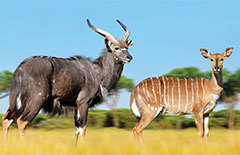
You might also like
At Franklin Park Zoo:
At Stone Zoo:

